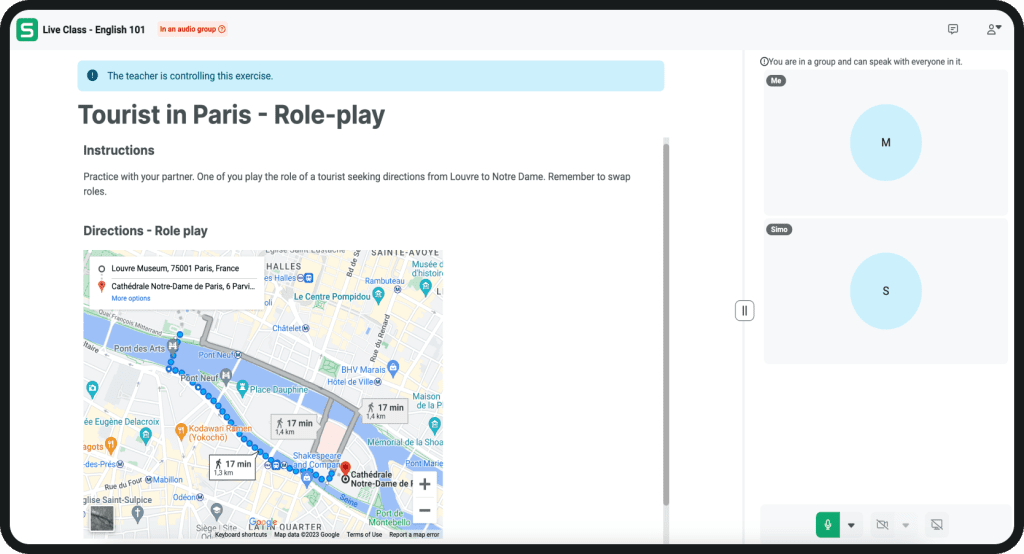Amid all the talk of AI and other advanced technologies transforming education, it’s tempting to ignore tried, tested and trusted approaches to language teaching and learning.
Role play has been part of language teaching for so long that it has perhaps become an under-appreciated tool or, at the very least, one that’s taken completely for granted. This post aims to redress that balance by highlighting why role play activities are so effective in the language classroom. We’ll also look at some different types of role play exercises and how to set them up. We’ll also provide you with some concrete examples to inspire your language teaching journey.
What is role play in language teaching?
Let’s start by defining terms so that we’re all on the same page.
A role play activity is an educational exercise in which individuals, pairs or groups assume specific roles or characters within a given scenario or context. Participants immerse themselves in these roles, often adopting different personas, to simulate real-life situations or interactions. They provide a hands-on, experiential approach to learning, allowing participants to practise and apply their knowledge and abilities in a dynamic and engaging manner.
For Rayhan (2014), speaking is at the heart of role play. He defines it as “an activity where students can express ideas, opinions, or feelings through words or articulation to others.”
When devising role plays, therefore, always consider how all learners can be given a clear role and opportunities to communicate through interactive dialogues.
Indeed Cornet (1999) is clear that when students are involved in role playing activities, there will be an increase in fluency and oral interaction skills. Rahayu (2015) goes further arguing that role play helps shy students, who have difficulty in conversation, by providing a mask, so they can improve their ability to speak and interact in any situation.
Advantages and disadvantages of role play activities
Role play activities are more than just fun and games; they are highly effective tools for language acquisition. Here’s some of the reasons why they work so well.
- Improved Speaking Fluency: Regular practice with role plays can lead to improved speaking fluency. Students become more comfortable expressing themselves spontaneously in the target language, which is invaluable in real-world conversations.
- Contextual Learning: Role plays create a contextual learning environment. Instead of just memorising isolated words or phrases, students learn how language functions in real-life communicative situations. This contextual understanding makes it easier for them to transfer their language skills to authentic, everyday interactions outside the classroom.
- Constructive Feedback: These activities provide natural opportunities for error correction and supportive feedback. As students participate in the activity, a teacher or peer can provide immediate feedback on language use, pronunciation and grammar. This allows students to quickly learn from their mistakes and make improvements, contributing to language proficiency.
- Enhanced Student Motivation: Role plays can be highly motivating for language learners. They add an element of fun and creativity to language classes, making learning enjoyable. When students are motivated, they are more likely to participate actively, practise more, and make progress in their language skills.
These advantages showcase the multifaceted benefits of integrating role plays into language learning activities. They not only enhance language skills but also promote critical thinking and overall confidence in using the target language.
Yet role plays are not without potential disadvantages. Language educators should be aware of these drawbacks and address them to maximise the benefits of role-play activities. Some disadvantages include:
- Anxiety and Shyness: Evidently role play activities can be intimidating for shy or anxious students. Some individuals may feel uncomfortable assuming different roles or performing in front of others, leading to reduced participation and learning. So, take care to ensure that all students have the opportunity to participate. Be mindful of individual learning needs and consider alternatives for students who may have special requirements or challenges.
- Unequal Participation: In group exercises, there’s a risk of unequal participation, with some students taking on more active roles while others remain passive observers. This can result in an unequal distribution of learning opportunities. Always consider the ideal group size for the role-play activity. Small groups (2-4 students) often work well as they encourage active participation and reduce anxiety for shy learners.
- Inauthenticity: In some cases, scenarios can feel forced or artificial, leading to unrealistic conversations. This can hinder the development of genuine communication skills and cultural understanding. Look to incorporate a variety of role-play scenarios to keep the learning experience fresh and engaging. Include everyday situations, professional interactions, and scenarios that expose students to different accents and dialects.
- Difficulty in Assessment: Assessing role play activities can be challenging. It may be difficult to objectively evaluate students’ performance, particularly in subjective areas such as language fluency or cultural sensitivity. If the role-play is part of an assessment, clearly communicate the assessment criteria to students in advance. Let them know how they will be evaluated and what aspects of their performance will be graded.
Using role play in your language classroom
Now, let’s dive into the practical aspects of using role plays effectively. Here’s the key steps to follow and to think about when putting lesson plans in place.
- Select appropriate scenarios: Choose role play scenarios that align with your students’ proficiency level and learning goals. Common examples that might work well include:
- Everyday Scenarios: These role plays mimic everyday situations like ordering food in a restaurant, asking for directions or shopping at a market. They are excellent for building practical language skills.
- Job Interviews: Simulating job interviews is ideal for advanced students. It helps them develop professional communication skills, such as introducing themselves, discussing qualifications and answering common interview questions.
- Role Play Games: Incorporate games like “Guess Who” or “Murder Mystery” in your classroom to add an element of fun. These activities encourage students to use descriptive language and deductive reasoning.
- Form groups: Divide your class into small groups, ideally 2-4 students per group. This encourages collaboration and minimises anxiety for shy learners.
- Provide guidelines: It is important to clearly explain the scenario, roles and objectives of the role play. Always include any specific vocabulary or phrases students should incorporate.
- Encourage authenticity: Encourage students to immerse themselves in their roles. Authenticity adds depth to the experience and enhances language acquisition.
- Debrief and feedback: After the role play, facilitate a discussion where students can reflect on their performance. Don’t forget to provide constructive feedback on language use and pronunciation.
Role play activities are dynamic and versatile tools for teaching English language or foreign languages. They immerse students in real-world situations, fostering language skills and building confidence. By incorporating these engaging activities into your language classroom, you can inspire your students to become more fluent and confident producers of their target language.
How Sanako makes it easy to arrange live role play activities in your language classes?
Tools like Sanako Connect offer a dedicated, online teaching platform that has also been specifically designed to help language educators improve students’ speaking skills, in both asynchronous or asynchronous settings. With Sanako Connect’s dedicated language instruction tools it is possible to:
- Easily divide students into virtual pairs or small groups for live role play activities or live conversation practice. This takes place live virtually using their laptops, tablets or smartphones, so each group of students can talk simultaneously inside the Sanako Connect platform without distracting other groups.
- Teachers can listen in or talk with different groups to assist as required. All individual pair/group conversations can be easily recorded and reviewed for feedback after the event, rather than interrupting live conversations.
- Teachers can share in real-time engaging resources to support the activities and provide context. This could include a wide variety of authentic real world materials including sound files, images, presentations, videos and other digital content.
- Provide detailed feedback via Connect’s feedback functionality. Students can immediately see where improvements need to be made. They can then relisten to the original audio material and record additional attempts.
If you’d like to find out more about how Sanako’s language teaching products could help transform your language teaching, please contact us now to arrange your FREE demo!


